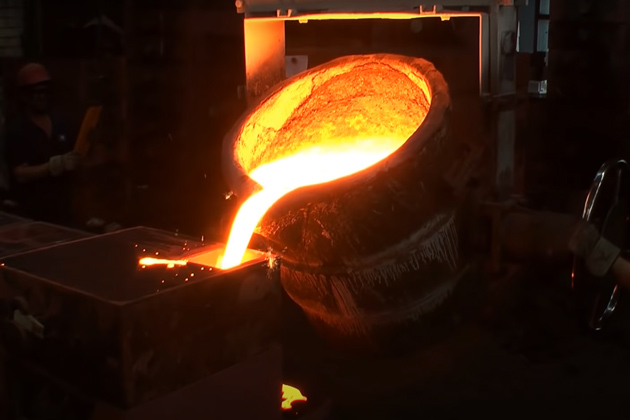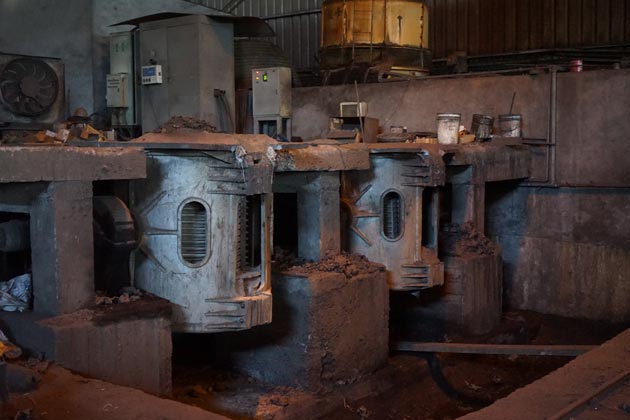Discover the Innovative Techniques Utilized in a Metal Foundry for Superior Casting Outcomes
In today's competitive production landscape, metal foundries are progressively adopting ingenious techniques to enhance casting results - Aluminum Foundry. Advanced computer simulations permit precise modeling of liquified metal actions, while 3D printing makes it possible for quick manufacturing of complicated molds. In addition, environmentally friendly products and automation simplify procedures. These growths promise substantial enhancements in performance and quality control. The impact of these innovations on sustainability and production methods continues to be to be totally explored.
Advanced Computer Simulations in Metal Casting
Advanced computer system simulations have actually changed the metal casting process by enhancing accuracy and efficiency. These sophisticated devices allow designers to develop virtual models of actors components, enabling them to forecast the actions and analyze of liquified metal during the casting phase. By replicating different criteria such as temperature level, circulation rate, and cooling rates, suppliers can determine possible issues before physical production starts.
This aggressive technique decreases waste and lessens expensive mistakes, inevitably leading to boosted product top quality. Furthermore, simulations assist in the optimization of mold layouts, ensuring that they satisfy the certain needs of each job. The assimilation of computational fluid characteristics (CFD) and finite element evaluation (FEA) additional adds to the accuracy of these simulations, giving insights that were formerly unattainable. Therefore, progressed computer system simulations have actually come to be an indispensable component of modern-day metal foundries, significantly progressing the market's abilities.
3D Printing for Mold And Mildews and Patterns
3D printing has actually become a groundbreaking technique for producing mold and mildews and patterns in the metal foundry industry. This innovation allows the fast production of complicated geometries that standard production techniques battle to attain. By utilizing additive production, foundries can produce detailed designs with minimized preparations and product waste. The ability to create mold and mildews as needed enables higher flexibility in design iterations, facilitating faster prototyping and alterations.
3D printing can use a selection of materials, consisting of metals and plastics, tailored to particular casting demands. This flexibility enhances the accuracy of mold and mildews, causing superior spreading results with improved surface finishes. Furthermore, the reduction in the variety of parts required streamlines assembly processes, even more maximizing production performance. As foundries remain to embrace 3D printing, they are poised to redefine sector requirements, leading the way for development and enhanced performance in metal spreading operations.
Eco-Friendly Products and Processes
As the metal foundry market encounters increasing pressure to lower its ecological impact, the fostering of eco-friendly products and procedures has actually ended up being crucial. Shops are currently exploring sustainable options to conventional products, such as using bio-based binders and recycled steels. These products not just reduce waste however also lower power intake during production.
In addition, innovations in sand spreading methods have led to making use of artificial sands that are less hazardous to the atmosphere. Foundries are additionally carrying out innovative procedures like liquified metal treatment that minimizes emissions and improves the top quality of actors items.
Moreover, water-based finishes have replaced poisonous solvents, promoting a safer workplace (Aluminum Casting). By integrating these environment-friendly techniques, metal foundries can markedly my site decrease their ecological impact while maintaining high-grade casting outcomes. This change not only profits the setting but also straightens with the expanding customer need for sustainable production remedies
Automation and Robotics in Foundry Workflow
While the metal foundry sector welcomes technology, the integration of automation and robotics is changing operations greatly. Automated systems enhance processes such as mold production, metal putting, and casting completing, substantially enhancing efficiency. Robotics help with the handling of hefty materials, minimizing the threat of work environment injuries and guaranteeing safer settings.

Further, using automated assisted lorries (AGVs) optimizes material transport within centers, ensuring timely delivery of parts to proper workstations. By applying these innovations, foundries can adjust to changing demands with higher agility, ultimately bring about enhanced profitability and competition in the market. As automation and robotics continue to advance, they hold the potential to redefine conventional foundry methods and drive more developments in casting methods.
Real-Time Surveillance and Quality Assurance Techniques
The advancements in automation and robotics have led the way for extra sophisticated strategies to quality control in metal foundries. Real-time monitoring systems use innovative sensors and information analytics to track critical criteria throughout the spreading process. These systems continually assess variables such as product, temperature, and stress make-up, making it possible for instant discovery of discrepancies from developed criteria.
Quality control methods currently incorporate device understanding formulas that analyze historical data to forecast potential defects prior to they take place. This proactive method reduces waste and improves total manufacturing performance. In addition, integrated feedback loops enable for quick changes, making certain that each spreading meets stringent quality demands.
The execution of electronic doubles-- virtual reproductions of physical possessions-- has actually also reinvented high quality assurance, allowing engineers to mimic and enhance processes in real-time. Together, these innovative methods substantially boost the dependability and quality of castings, setting brand-new sector requirements in metal foundry operations.
Frequently Asked Inquiries
What Sorts of Metals Are Typically Cast in Factories?
Commonly cast steels in foundries consist of aluminum, brass, iron, and bronze. Each metal read this shows distinct homes, making them suitable for numerous applications, such as vehicle parts, machinery, and imaginative sculptures, enhancing their versatility in production.

For how long Does the Casting Refine Typically Take?
The casting procedure typically takes a number of hours to days, depending on aspects such as the intricacy of the mold and mildew, type of metal used, and cooling needs. Each phase affects the overall period considerably.
What Safety Procedures Remain In Place for Foundry Workers?

Just how Are Problems in Castings Identified and Addressed?
Issues in castings are recognized through visual examinations and non-destructive testing techniques. Once discovered, foundry workers resolve them by fine-tuning processes, adjusting product make-ups, and implementing rehabilitative actions to ensure high quality and compliance with criteria.
What Is the Expense Array for Metal Casting Services?
The price variety for metal spreading services typically ranges $1 to $10 per extra pound, depending upon factors such as product type, intricacy of the style, and production quantity, affecting overall prices significantly.
In today's competitive production landscape, metal foundries are increasingly adopting innovative techniques to boost casting outcomes. As the metal foundry industry encounters boosting pressure to minimize its environmental impact, the adoption of environment-friendly materials and processes has ended up being important. Foundries are currently discovering sustainable choices to conventional products, such as using bio-based binders and recycled steels. By incorporating these eco-friendly techniques, metal foundries can noticeably decrease their environmental influence while maintaining top notch spreading outcomes. The developments in automation and robotics have led the means for much more innovative approaches to top quality assurance in metal foundries.